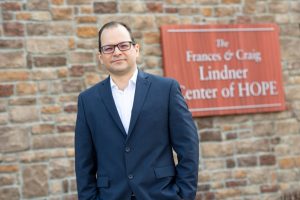Lindner Center of HOPE Associate Chief Research Officer Awarded NIMH Grant
The National Institute of Mental Health (NIMH) has awarded a $3.4 million grant to the Lindner Center of Hope’s Dr. Francisco Romo-Nava, MD, PhD. Dr. Romo-Nava is Associate Chief Research Officer at the Lindner Center of Hope and Associate Professor at the University of Cincinnati (UC) Department of Psychiatry and Behavioral Neuroscience. This phased innovation R61/33 grant is titled “Modulating spinal interoceptive pathways to evaluate their role and therapeutic potential in MDD symptomatic domains” and will study a novel non-invasive form of spinal cord neuromodulation to study and treat major depressive disorder (MDD).
The multidisciplinary study team is led by principal Investigator and physician-scientist Dr. Romo-Nava and Co-Investigators Dr. Susan L. McElroy, MD, Chief Research Officer at the Lindner Center of Hope, Drs. Jeffrey Welge, PhD, and Dave Fleck, PhD at UC’s Department of Psychiatry and Behavioral Neuroscience, Dr. Oluwole Awosika, MD at UC’s Department of Neurology and Rehabilitation Medicine, and Dr. Ishita Basu, PhD at UC’s Department of Neurosurgery. Dr. Martin Paulus from the Laureate Institute for Brain Research and Dr. Jeff Liu Chang-chia, PhD, from the University of Virginia, will be consultants on the study. Key team members at the Lindner Center of HOPE Research Institute are the lead research coordinator Georgi Georgiev, Research Nurse Nicole Mori, Biostatistician Thomas J. Blom, Dr. Anna I. Guerdjikova, Jakyb Stoddard, Aspen Madrid, and Genie Groff.
This study builds on a successful pilot clinical trial conducted by the research team at the Lindner Center of Hope and funded by a NARSAD Brain and Behavior Research Foundation Young Investigator Award (Dr. Romo-Nava), which also served as the basis for a USPTO patent (#10,857,356) issued for transcutaneous spinal cord stimulation for the treatment of psychiatric disorders. The intervention involved brief sessions where a mild and generally well-tolerated current is applied through the skin using an electrode placed at the level of the mid-back and another electrode placed over the shoulder. The pilot study showed therapeutic potential for this novel approach and was recently published at one of the top scientific journals in the field of psychiatry (https://www.nature.com/articles/s41380-023-02349-9).
This new R61/33 grant involves a project with two phases. During the first phase (R61 phase), the project will evaluate whether a non-invasive form of spinal cord stimulation at different doses can reach and modulate specific spinal interoceptive pathways among adults with MDD. These are neuronal pathways in the spinal cord that convey information about bodily states to the brain and are thought to be relevant for emotional experience and the concept of mood. This first phase will last two years and is expected to identify neurophysiological markers of target engagement that will inform on the optimal dose to modulate these spinal interoceptive pathways. Recruitment for the first phase is expected to start 12/2024.
If successful, the team will then conduct the second phase (R33 phase). This phase involves an 8-week double-blinded, randomized, sham-controlled clinical trial to evaluate the efficacy and safety of this form of non-invasive spinal cord stimulation among participants with MDD. During this clinical trial the team will also aim to replicate the target engagement markers identified in the first phase and evaluate their relevance for treatment response. The second phase is expected to have a duration of three years.
When completed, the project is expected to generate important new knowledge on the role of brain-body interaction pathways in MDD and the potential of spinal interoceptive pathways as novel therapeutic targets. The results of this project will inform on the potential efficacy and safety of non-invasive spinal cord stimulation as a new tool to study and treat MDD and will guide future studies.
